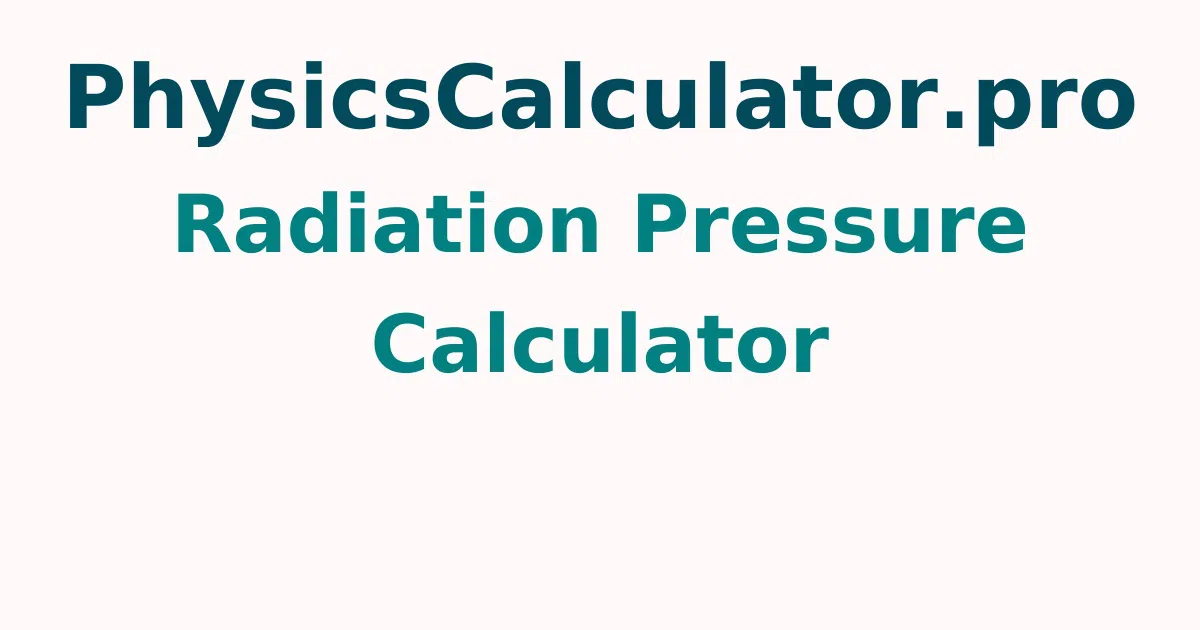Radiation Pressure Calculator
To calculate the radiation pressure inside and outside the sun, use the Radiation Pressure Calculator. Simply enter the required information, such as the type of surface, luminosity, distance, and temperature, then press the calculate button to receive the result in a matter of seconds, along with a detailed explanation.
Radiation Pressure Definition & Formula
Electromagnetic waves can carry momentum in addition to energy. Photons are the particles that make up electromagnetic energy. Photons' momentum will be absorbed or reflected.
The radiation pressure is the force exerted on a surface as a result of the object's momentum being exchanged with the electromagnetic field. The solar radiation pressure is caused by the sun's energy reaching closer ranges.
- The formula for Radiation pressure outside the star = p = x * L * cos²(α) / (4 * π * R² * c)
- Radiation pressure inside the star = p = 4 * σ * T⁴ / (3 * c)
- Where, c = speed of light
- p = radiation pressure
- T = temperature
- R = distance from star
- σ = Stefan-Boltzmann constant
- σ = 5.670367 x 10^-8 W/(m² - K⁴)
- L = luminosity of star
- x = type of surface
- α = angle between the light beam and the surface of absorbing/reflecting surface
How to Calculate Radiation Pressure?
The steps to quickly determine the solar radiation pressure are as follows.
- Step 1: Make a list of the information provided in the question.
- Step 1:Multiply the surface value by the luminosity and the angle's cos square.
- Step 2: Calculate the square of the distance from the star, the speed of light, and 4π as a product.
- Step 3: To calculate the radiation pressure outside, multiply the product from steps 2 and 3.
- Step 4: Multiply the 4 times of constant with the temperature to the power 4.
- Step 5: To calculate the inner star pressure, multiply it by three times the speed of light.
For more concepts check out physicscalculatorpro.com to get quick answers by using this free tool.
What are Solar Sails?
A solar sail (also known as a light sail or a photon sail) is a hypothetical technique of moving across space that relies on the radiation pressure imposed by sunlight on enormous mirrors. It's the same as when the wind blows a sail on a sailing boat. People wanted to test the notion of solar sails, so in 2005, they launched Cosmos 1, an orbital spacecraft with eight sail blades, for the first time (15 m long with a total surface area of 600 square meters). Unfortunately, the engine failed in the 83rd second of the flight, and the entire vehicle crashed into the water. However, several more satellites equipped with the light sail technology have been successfully launched into Earth's orbit.
Radiation Pressure Examples
Question 1: If the star's surface is opaque, it has a luminosity of 1 solar, a distance of 1 au, and a temperature of 8000000 K. How can you determine the radiation pressure?
Solution:
Given:
Type of surfae = opaque. Hence, x = 1
Luminosity = 1 solar luminosity
distance R = 1 au
Temperature T = 8000000 K
Outside sun radiation pressure p = x * L * cos^2(α) / (4 * π * R^2 * c)
p = 1 x 1 x cos^2(0)/(4 x 3.14 x 1 x 299792458)
= 4.54
Inside radiation pressure p = 4 * σ * T^4 / (3 * c)
p = 4 * 5.670367 x 10^-8 * (8000000)^4/ (3 * 299792458)
= 1032.97 GPa
Hence, the pressure inside the star is 1032.97 GPa, outside the star is 4.54 μPa.
FAQs on Radiation Pressure
1. What is meant by radiation pressure?
The pressure imposed on a surface by electromagnetic radiation impinging on it is created by the momentum carried by the radiation; the radiation pressure is double if the radiation is reflected rather than absorbed.
2. What do you understand by the pressure of radiation shows that the pressure of radiation is equal to energy density?
An electromagnetic wave's radiation pressure is proportional to its energy density. If the wave is reflected, the pressure is equal to twice the electromagnetic energy intensity, and if the wave is absorbed, the pressure is equal to the incident energy intensity.
3. What is the radiation pressure of a star?
Electromagnetic radiation exerts a minor force on everything it comes into contact with. The mass of the most massive stars is supported mostly by radiation pressure against gravity, a scenario that eventually establishes the upper limit for how massive a star may become.
4. What method is used to determine the intensity of radiation?
The quantity of ionisation caused by x-rays or gamma rays can be used to determine their intensity. Exposure is the quantity of ionisation in the air caused by the radiation. A roentgen is a scientific unit of measurement for exposure (R or r).
